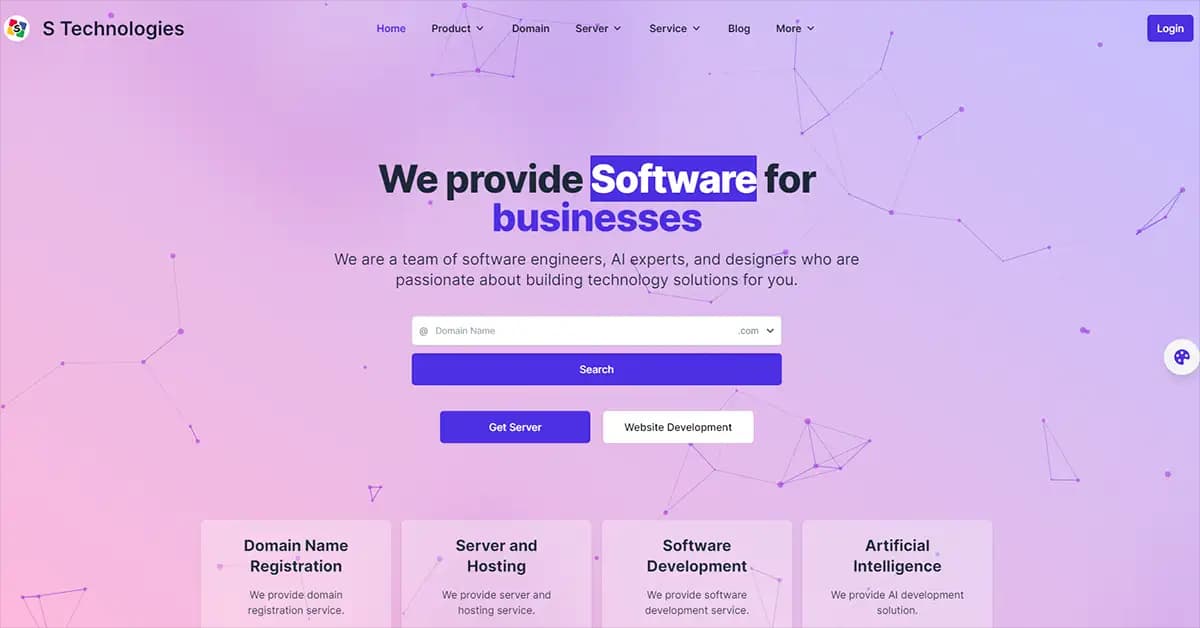Introduction
What is WP-Next? 🤔
WP-Next (WordPress-Next) is a sleek, fast, and fully customizable blog frontend powered by Next.js and Tailwind CSS—all backed by the WordPress REST API. If you're looking for a modern blog that loads like lightning ⚡ but still gives you the power of WordPress, you’ve just found your new best friend!
Why Use WP-Next? 🏆
Let’s face it—WordPress is fantastic, but its default themes can sometimes feel… outdated. WP-Next brings speed, flexibility, and beauty together for the perfect blogging experience. Whether you're a developer, writer, or entrepreneur, WP-Next ensures your blog is as stunning as your content!
Who Developed WP-Next? 🏗️
WP-Next is proudly developed by S Technologies, a research-based tech company in Bangladesh. With a passion for AI, web development, and open-source projects, they’ve created WP-Next as a free, open-source solution for bloggers and developers alike!
Key Features ✨
WP-Next isn’t just another blog frontend—it’s a feature-packed beast! Here’s why you’ll love it:
| 🌟 Feature | 🚀 Benefit |
|---|---|
| Fully Responsive 📱 | Looks stunning on all devices! |
| SEO-Friendly 🔍 | Optimized for search engines to boost your rankings. |
| Light & Dark Mode 🌞🌙 | Choose your preferred theme effortlessly. |
| Super Fast Loading ⚡ | Built with Next.js for ultimate speed. |
| Google Analytics 📊 | Track your traffic with ease. |
| Sitemap & Robots.txt 📄 | Boosts SEO with proper indexing. |
| Image Optimization 🖼️ | Lazy loading for faster performance. |
| Powered by WordPress 📝 | Enjoy all the WordPress features with a modern frontend. |
And guess what? It’s 100% free and open-source! 🎉
Installation Guide 🛠️
Getting started with WP-Next is as easy as 1-2-3!
🏗️ System Requirements
Before you begin, make sure your system is ready:
✅ Node.js >= 18
✅ Next.js >= 14
✅ TailwindCSS >= 3
✅ WordPress >= 5.7
✅ WordPress REST API enabled
🚀 Step-by-Step Installation
1️⃣ Clone the repository
git clone github.com/STechBD/WP-Next.git
2️⃣ Install dependencies
npm install
3️⃣ Configure your setup
Modify wp-next.config.js to match your WordPress site.
4️⃣ Set up environment variables
Create a .env file:
touch .env
Modify it like this:
DOMAIN=wp-next.stechbd.net
SITE=https://wp-next.stechbd.net
API=https://exampleapi.com/wp-json/wp/v2
GA=True
GA_TRACKING_ID=G-XXXXXXXXXX
IMAGE_DOMAINS=example.com,example.net,gravatar.com
ROBOTS_ALLOW=/
ROBOTS_DISALLOW=/admin,/login
5️⃣ Run WP-Next in development mode
npm run dev
6️⃣ Build and start in production
npm run build
npm run start
7️⃣ Visit your blog and enjoy! 🎉
Open http://localhost:3000 and see your stunning blog in action!
How to Use WP-Next? 📖
Once you've installed WP-Next, it's time to explore how to use it like a pro!
📝 Creating and Managing Posts
Since WP-Next is powered by the WordPress REST API, all content is managed directly in your WordPress dashboard.
✅ Login to your WordPress admin panel
✅ Create a new post under Posts → Add New
✅ Add categories, tags, and a featured image
✅ Publish, and it will automatically appear on WP-Next!
💡 Pro Tip: Use the "Excerpt" section in WordPress to control the summary displayed on the homepage!
Customization 🎨
WP-Next is highly customizable to match your branding and style.
🌈 Changing Colors and Fonts
All styles are handled by Tailwind CSS, so you can easily modify them in tailwind.config.js.
module.exports = {
theme: {
extend: {
colors: {
primary: "#1e40af", // Change primary color here
},
fontFamily: {
sans: ["Inter", "sans-serif"], // Update fonts
},
},
},
};
🎭 Light/Dark Mode
WP-Next supports automatic dark mode using Tailwind's dark: classes. If you want to force dark mode, update the theme setting in globals.css.
🖼️ Custom Logo & Favicon
Replace the default logo in public/ with your own files:
/public/logo.png
/public/favicon.ico
Or edit components/Navbar.js to load a different logo dynamically.
🏗️ Editing Layout
You can modify the blog layout in pages/index.js or tweak individual post layouts in components/Post.js.
SEO Optimization 🔍
SEO is crucial for growing your blog, and WP-Next has built-in SEO features!
✅ Optimizing Meta Tags
Edit components/SEO.js to modify default meta tags. WP-Next automatically pulls SEO metadata from WordPress, but you can add more structured data.
<Head>
<title>{post.title.rendered} - My Blog</title>
<meta name="description" content={post.excerpt.rendered} />
<meta property="og:title" content={post.title.rendered} />
<meta property="og:image" content={post.featured_image} />
</Head>
📍 Adding Google Analytics
Enable Google Analytics by setting your tracking ID in .env:
GA=True
GA_TRACKING_ID=G-XXXXXXXXXX
🗺️ Generating a Sitemap
WP-Next automatically generates an XML sitemap using sitemap.js. Just run:
npm run sitemap
🚫 Controlling Robots.txt
Modify robots.txt rules in .env:
ROBOTS_ALLOW=/
ROBOTS_DISALLOW=/admin,/login
Performance Enhancements ⚡
WP-Next is blazing fast, but you can make it even faster!
🏎️ Image Optimization
Use Next.js’s built-in <Image> component to enable lazy loading and automatic compression:
import Image from "next/image";
<Image
src={post.featured_image}
alt={post.title.rendered}
width={800}
height={450}
priority={false} // Lazy load images
/>
🚀 Enabling Caching
Improve performance with Next.js API caching. Modify next.config.js to increase cache duration:
module.exports = {
async headers() {
return [
{
source: "/(.*).json",
headers: [{ key: "Cache-Control", value: "public, max-age=86400" }],
},
];
},
};
🌍 Deploying with Vercel
Vercel is the best way to deploy WP-Next. To deploy:
vercel login
vercel deploy
Here’s the next part of your blog post, covering Advanced Features, Security Best Practices, Future Roadmap, and Why Choose WP-Next! 🚀🔐
Advanced Features 🚀
WP-Next isn’t just another WordPress frontend; it’s packed with powerful features to take your blog to the next level.
🔗 Dynamic Routing for SEO-Friendly URLs
WP-Next automatically generates SEO-friendly URLs for your posts and pages using dynamic routes in pages/[slug].js.
export async function getServerSideProps({ params }) {
const res = await fetch(`https://news.ulkaa.com/wp-json/wp/v2/posts?slug=${params.slug}`);
const post = await res.json();
return { props: { post: post[0] } };
}
This ensures that every blog post gets its own clean, shareable URL!
🏷️ Categories & Tags Filtering
WP-Next supports category-based filtering for easy content discovery. You can add category-based navigation by modifying pages/category/[category].js.
const res = await fetch(`https://news.ulkaa.com/wp-json/wp/v2/posts?categories=${categoryId}`);
This lets users browse articles based on specific topics!
📢 Social Media Auto-Sharing
WP-Next integrates social sharing buttons so visitors can easily share articles on Facebook, Twitter, and WhatsApp.
<a href={`https://twitter.com/intent/tweet?url=${post.link}`} target="_blank">
Share on Twitter
</a>
🔍 Instant Search
WP-Next includes lightning-fast search powered by Next.js API routes. You can improve it further using Algolia InstantSearch for a real-time experience!
const res = await fetch(`https://news.ulkaa.com/wp-json/wp/v2/search?search=${query}`);
Security Best Practices 🔐
Security is critical when running a public-facing blog. WP-Next follows best security practices to keep your data safe.
🛡️ Enable HTTPS
Always use HTTPS when hosting WP-Next. If deploying on Vercel, SSL is enabled by default. Otherwise, configure Nginx:
server {
listen 443 ssl;
server_name yourdomain.com;
ssl_certificate /etc/letsencrypt/live/yourdomain.com/fullchain.pem;
ssl_certificate_key /etc/letsencrypt/live/yourdomain.com/privkey.pem;
}
🔑 Secure API Keys
Never expose your API keys in frontend code! Use environment variables instead:
NEXT_PUBLIC_API_BASE=https://news.ulkaa.com/wp-json
🛑 Prevent Brute Force Attacks
Limit login attempts to protect against brute force attacks. If your WordPress site is behind WP-Next, install a security plugin like Wordfence.
🏰 Protect Against XSS & CSRF
WP-Next automatically escapes user inputs, but you should also use security headers in next.config.js:
module.exports = {
async headers() {
return [
{
source: "/(.*)",
headers: [
{ key: "X-Frame-Options", value: "DENY" },
{ key: "X-XSS-Protection", value: "1; mode=block" },
],
},
];
},
};
Future Roadmap 🚀
We’re constantly working on improving WP-Next! Here’s what’s coming next:
🎯 Upcoming Features
✅ Multilingual Support 🌍 – Add support for multiple languages
✅ PWA Support 📱 – Enable offline access and push notifications
✅ Custom Theme Builder 🎨 – Full UI customization with a drag-and-drop editor
✅ Newsletter Integration ✉️ – Built-in email subscription system
Got ideas? Drop your feature requests in the comments! 💬
Why Choose WP-Next? 🤔
Still wondering why WP-Next is the best WordPress frontend? Here’s why:
⚡ Blazing Fast
🚀 Next.js SSR & ISR for fast page loads
🚀 Image Optimization reduces bandwidth usage
🚀 Static & Dynamic Rendering for best performance
🔒 Secure & Scalable
🛡️ Headless WordPress – No direct database exposure
🛡️ API-based Content Fetching – Minimal attack surface
🛡️ CDN & Caching Support – Handles high traffic loads
🎨 Fully Customizable
🎭 Dark Mode & Custom Styling
🎭 Modify Layouts Easily
🎭 Control SEO & Meta Tags
🆓 Free & Open-Source
💡 WP-Next is 100% open-source, meaning you can tweak it to your needs and contribute to its growth!
🔗 Try WP-Next today and build a powerful, modern blog!

